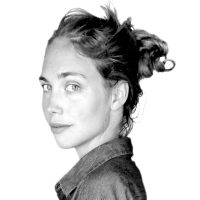Two were passed out on a small futon, and a third was snoring on the radiator next to me. Another with a distinguished white goatee was resting high up on a wooden ledge, licking himself in a patch of dimmed light. One took an exploratory whiff of my sock. Still another watched the film intently, perched sphinx-like on a bean bag.
It was movie night at the Koneko cat café on Manhattan’s Lower East Side, where 12 felines and 22 humans gathered in the basement cattery to watch Miranda July’s The Future, about a thirtysomething couple in the throes of an existential crisis.
The couple decides to adopt a wounded stray cat, Paw Paw, who represents an attempt to get their lives together and rescue their limping relationship. Paw Paw, the film’s omniscient narrator, has a scratchy voice that sounds eerily like that of the possessed boy in The Shining.
I expected a mad rush for the door when the movie opened with Paw Paw posing the question, “Have you ever been outside?” But the cats at Koneko were unfazed. Many dozed off shortly after the lights went down. Others stalked the room silently, sprawling out next to space heaters and sniffing bags of popcorn.
Later, I learned that many of the cats at Koneko have been outside—sort of. The space includes an enclosed outdoor “catio” in addition to two living room areas, which are separated from the restaurant by a glass wall and a foyer where cattery visitors swap their shoes for spa slippers.
A ramp traverses the two floors, so the cats can roam freely between the upstairs and downstairs catteries.
Koneko is modeled after popular cat cafés in Japan, with one key distinction: the New York Health Department doesn’t permit felines to hang out where food is prepared. Koneko serves coffee, wine, beer, sake, pastries, and traditional Japanese appetizers like hiyayakko (tofu) and tsukemono (pickled vegetables).
But the main attraction is of course the cats.
“We’re basically a bona fide foster home,” said Koneko founder Benjamin Kalb, 27, who opened the café three months ago in partnership with Anjellicle Cats Rescue, which specializes in saving cats from being euthanized at the city’s publicly funded shelters. Koneko visitors pay $15 an hour to socialize with the cats, which are all adoptable.

No longer unique to Japan, cat cafés exist in most major cities in the U.S., according to Kalb.
Koneko has one competitor in New York City: Meow Parlour, also in the Lower East Side, which opened in December 2014. The model is less integrative than Koneko’s; pastries are bussed over from the Meow Parlour Patisserie around the corner.
At Koneko, Kalb set out to create a “super cat-centric environment,” unlike Petco and most shelters, where the cats are cooped up in cages. “You can’t really tell their personalities when they’re living like that, or how they interact with people and with other cats,” said Kalb, who chatted with me after the film in the café.
Kalb hoped the novelty of watching movies that feature cats in a room full of cats would attract new visitors. So far it’s been a success: all three screenings have sold out, with maximum seating capacity at 22 people. Tickets cost $30 and include popcorn and a beverage (beer, wine, or coffee), plus quality time with Koneko’s fleecey residents.
I was one of few people who came to movie night alone. Most visitors were there with dates—girlfriends, boyfriends, and one mother-daughter couple.
The first half of the film was a Zen-like experience: torpor descended when the lights went down, with cats arching their backs and stretching their forepaws in preparation for a snooze. Some purred and rubbed their ears against outstretched hands. They tiptoed on various ledges around the room like tightrope walkers.
The couples instinctively imitated the cats, nuzzling shoulders and burying their heads in each other’s necks. These were cat people, after all.
Everyone grew restless as the movie dragged on: one calico biffed a black-and-white “cow cat” who encroached on her territory; an irascible tabby batted at my shoelace, its tail ticking back and forth like a metronome. The film’s tense silences were suddenly punctuated by hisses and snarls.
“We usually feed them at 9:00, so they’re getting a little hangry,” said Anne Paolini, a young employee who hung around with a handful of lingering visitors after the movie.
Everyone addressed the animals in strange falsettos. They made cat jokes and traded stories about their cats’ neuroses.
Paolini explained that one of the cats hiding behind a bean bag was named “Bootycall” by a shelter, because singular names stand out more on sites like Petfinder. “She only comes out at 2:00 AM,” she said to hearty laughs.
“My family has five cats, so it’s pretty similar to this,” another young woman, Rhi, told me. She and her girlfriend have two cats in their Manhattan apartment and “would love a third.”
Adam, 27, and his girlfriend, Sheila, 26, came to the film because they love cats but can’t have any in their apartment. “It was hard to resist the urge not to touch all the cats!” Sheila enthused.
Adam was already excited about the next movie night at Koneko. “I think they’re going to show Catwoman with Halle Berry,” he said. “That one should be interesting.”





